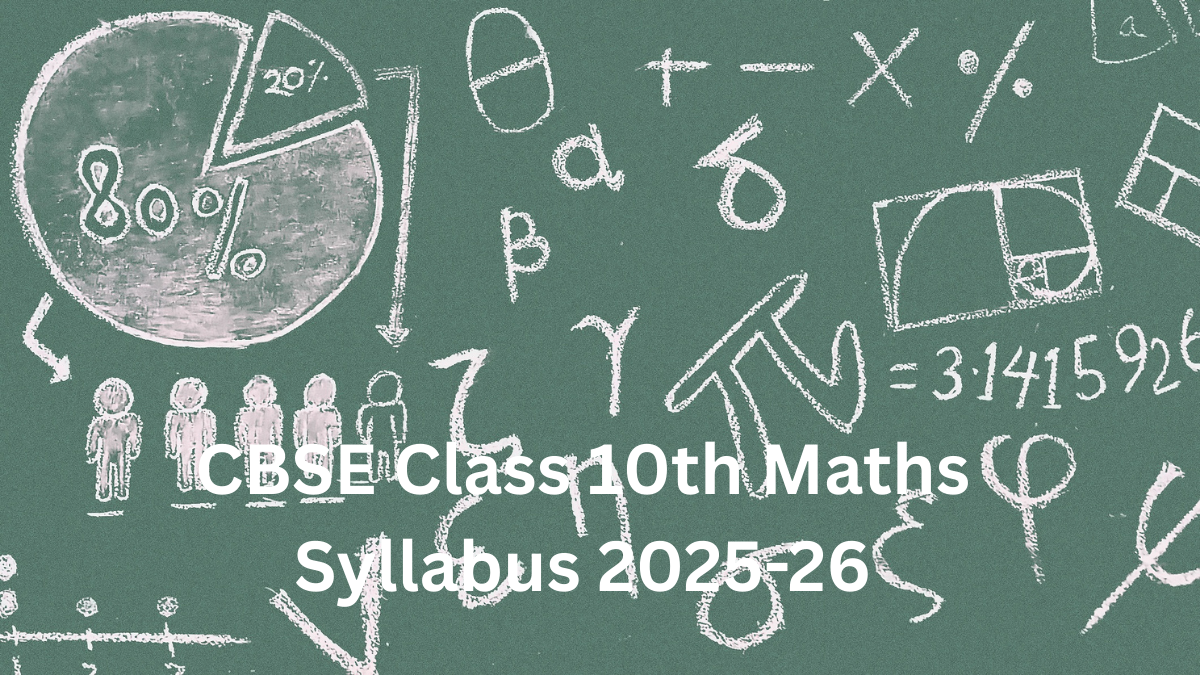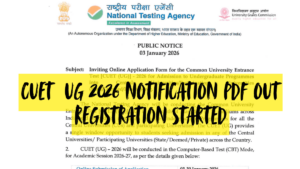CBSE Class 10th Maths Syllabus 2025-26: As September approaches, most schools are prepared to hold half-yearly tests in the tenth class students. To assist students in organizing their Math preparation, we have posted the Class 10 Maths Half Yearly Syllabus 2025 on this page, which includes a full review of each topic. Examine the official CBSE Class 10 Maths Half Yearly Syllabus 2025-26 and pass the board exam with high marks.
CBSE Class 10th Maths Syllabus 2025-26
At the start of the academic year, the Central Board of Secondary Education has released the CBSE Class 10th Maths Syllabus 2025-26 along with all other subjects. The CBSE 10th Maths Syllabus has been released for standard and basic courses in PDF format on the official portal.
The Class 10th Maths Syllabus contains 14 chapters organised into five units: Number Systems, Algebra, Coordinate Geometry, Geometry, Trigonometry, Mensuration, and Statistics & Probability. To achieve good marks in the maths exam, students need to master and learn the concepts of all the topics sincerely.
Download CBSE Class 10th Maths Syllabus 2025 PDF- Click here
CBSE Class 10 Maths Syllabus 2025-26 Highlights
In the class 10 curriculum, Maths is one most scoring subjects, although most students consider it most toughest one. To score well in the maths paper, aspirants need to have a good conceptual clarity of all the topics mentioned in the official CBSE Board Maths Class 10 Syllabus 2025. Refer to the table for the 10th class maths unit-wise weightage
| Unit Number | Unit Name | Marks |
| I | NUMBER SYSTEMS | 06 |
| II | ALGEBRA | 20 |
| III | COORDINATE GEOMETRY | 06 |
| IV | GEOMETRY | 15 |
| V | TRIGONOMETRY | 12 |
| VI | MENSURATION | 10 |
| VII | STATISTICS AND PROBABILITY | 11 |
| Total Marks | 80 | |
| Internal Assessment | 20 | |
| Grand total | 100 | |
CBSE Board Maths Class 10 Syllabus Unit-wise
In the whole syllabus, there are a total of seven units, and each again divided into several topics and subtopics. Belo, we have provided a complete unit-wise breakdown of the CBSE 10th Maths Syllabus 2025-26.
UNIT I: NUMBER SYSTEMS
1. REAL NUMBERS
1. Fundamental Theorem of Arithmetic – statements after reviewing work done earlier and after illustrating and motivating through
examples
2. Proofs of irrationality of √2, √3, √5
UNIT II: ALGEBRA
1. POLYNOMIALS
1. Zeros of a polynomial
2. Relationship between zeros and coefficients of quadratic polynomials.
2. PAIR OF LINEAR EQUATIONS IN TWO VARIABLES
1. Pair of linear equations in two variables and graphical method of their solution, consistency/inconsistency.
2. Algebraic conditions for number of solutions.
3. Solution of a pair of linear equations in two variables algebraically – by substitution, by elimination. Simple situational problems.
3. QUADRATIC EQUATIONS
1. Standard form of a quadratic equation 𝑎𝑥² + 𝑏𝑥 + 𝑐 =0, (𝑎 ≠ 0).
2. Solutions of quadratic equations (only real roots) by factorization, and by using quadratic formula. Relationship between discriminant and nature of roots.
3. Situational problems based on quadratic equations related to day-to-day activities to be incorporated
4. ARITHMETIC PROGRESSIONS
1. Motivation for studying Arithmetic Progression
2. Derivation of the nth term and sum of the first n terms of AP and their application in solving daily life problems.
UNIT III: COORDINATE GEOMETRY
1. Coordinate Geometry
1. Review: Concepts of coordinate geometry. Distance formula. Section
formula (internal division)
UNIT IV: GEOMETRY
1. TRIANGLES
Definitions, examples, counter examples of similar triangles.
1. (Prove) If a line is drawn parallel to one side of a triangle to intersect the other two sides in distinct points, the other two sides are
divided in the same ratio.
2. State (without proof) If a line divides two sides of a triangle in the same ratio, the line is parallel to the third side.
3. State (without proof) If in two triangles, the corresponding
angles are equal, their corresponding sides are proportional and the
triangles are similar.
4. State (without proof) that if the corresponding sides of two triangles are proportional, their corresponding angles are equal, and the two
triangles are similar.
5. State (without proof): If one angle of a triangle is equal to one angle of another triangle and the sides including these angles are proportional, the two triangles are similar
2. CIRCLES
Tangent to a circle at point of contact.
1. (Prove) The tangent at any point of a circle is perpendicular to the radius through the point of contact.
2. (Prove) The lengths of tangents drawn from an external point to a circle are equal
UNIT V: TRIGONOMETRY
1. INTRODUCTION TO TRIGONOMETRY
1. Trigonometric ratios of an acute angle of a right-angled
triangle. Proof of their existence (well defined)
2. Motivate the ratios whichever are defined at 0° and 90° . Values of the trigonometric ratios of 30° , 45° and 60°.
3. Relationships between the ratios.
2. TRIGONOMETRIC IDENTITIES
1. Proof and applications of the identity sin2A + cos2A = 1.
2. Only simple identities to be given.
3. HEIGHTS AND DISTANCES:
Angle of elevation, Angle of Depression.
1. Simple problems on heights and distances. Problems should not involve more than two right triangles. Angles of elevation / depression
should be only 30°, 45°, and 60°
UNIT VI: MENSURATION
1. AREAS RELATED TO CIRCLES
1. Area of sectors and segments of a circle.
2. Problems based on areas and perimeter/circumference of the above
said plane figures. (In calculating area of segment of a circle, problems should be restricted to central angle of 60°, 90° and 120° only
2. SURFACE AREAS AND VOLUMES
1. Surface areas and volumes of combinations of any two of the following: cubes, cuboids, spheres, hemispheres and right circular cylinders/cones.
UNIT VII: STATISTICS AND PROBABILITY
1. STATISTICS
1. Mean, median and mode of grouped data (bimodal situation to be avoided)
2. PROBABILITY
1. Classical definition of probability.
2. Simple problems on finding the probability of an event.
Books for CBSE Class 10th Maths Syllabus
To master the Class 10th maths syllabus, you might need some books that exactly replicate the topics mentioned in the official CBSE Class 10 Maths syllabus. Here is a list of Class 10 Mathematics reference books.
1. Mathematics – Textbook for class IX – NCERT Publication
2. Mathematics – Textbook for class X – NCERT Publication
3. Guidelines for Mathematics Laboratory in Schools, class IX – CBSE Publication
4. Guidelines for Mathematics Laboratory in Schools, class X – CBSE Publication
5. Laboratory Manual – Mathematics, secondary stage – NCERT Publication
6. Mathematics exemplar problems for class IX, NCERT publication
7. Mathematics exemplar problems for class X, NCERT publication.
| CBSE Class 10 Sample paper of Other subjects | |
| Class 10 Hindi Sample Paper with Solutions | Class 10 SST Sample Paper with Solutions |
| Class 10 English Sample Paper with Solutions | Class 10 Maths Sample Paper with Solution |
| Class 10 Science Sample Paper with Solutions | Class 10 Computer Sample Paper with Solution |











 NEET UG 2026 Registration: NTA releases ...
NEET UG 2026 Registration: NTA releases ...
 CUET UG 2026 Online Registration Started...
CUET UG 2026 Online Registration Started...
 CUET 2026 Free Batches Launched by CUET ...
CUET 2026 Free Batches Launched by CUET ...














